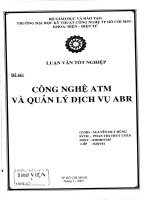cong nghe atm
Bạn đang xem bản rút gọn của tài liệu. Xem và tải ngay bản đầy đủ của tài liệu tại đây (608.02 KB, 30 trang )
<span class='text_page_counter'>(1)</span><div class='page_container' data-page=1>
<b>Chapter 5</b>
</div>
<span class='text_page_counter'>(2)</span><div class='page_container' data-page=2>
<b>Overview</b>
•
<b><sub>Introduction</sub></b>
•
<b>Technical basics</b>
•
<b>Frame Relay network </b>
</div>
<span class='text_page_counter'>(3)</span><div class='page_container' data-page=3>
<b>Introduction </b>
<b>What is Frame Relay?</b>
</div>
<span class='text_page_counter'>(4)</span><div class='page_container' data-page=4>
<b>What is Frame Relay ?</b>
• A high speed communication technology used in networks to
connect LAN, SNA, Internet & carry voice traffic
– Speeds: 56Kbps – 1.54Mbps
• Information is divided into “frames” before transmitting
• “Frames” are simply “relayed” through series of switches within
the network
– Each has an address that the network uses to determine the
destination
– No error correction or recovery, discards data if there’s problem
– Relies on higher layer protocol to recover
• Operates at Layer 1 & Layer 2 of OSI model
</div>
<span class='text_page_counter'>(5)</span><div class='page_container' data-page=5>
<b>Applications of Frame Relay</b>
• File Transfer
– Character-interactive traffic (e.g. text editing)
– High Resolution graphics
• Access to Internet and Intranet
• Multimedia, Real Time Voice, Video, Fax
• LAN Peer-to-Peer, WAN Interconnection
• Multi-protocol networking applications
– ATM, SNA, TCP/IP
</div>
<span class='text_page_counter'>(6)</span><div class='page_container' data-page=6>
<b>Technical Basics</b>
•
<b><sub>Network Interfaces</sub></b>
•
<b>Frame Format</b>
</div>
<span class='text_page_counter'>(7)</span><div class='page_container' data-page=7>
<b>Frame Relay Layers</b>
• F.R. operates at PHY and MAC layers of OSI model
• It is an interface standard
– Specifies what CPE must do to connect
</div>
<span class='text_page_counter'>(8)</span><div class='page_container' data-page=8>
<b>Network Interfaces</b>
• <i><b>UNI – User Network Interface</b></i>
– a set of procedures that allow a frame relay access equipment to
communicate with the FR network
• <i><b>LMI – Local Management Interface</b></i>
– Ensures valid operation of the local frame relay UNI
– Provides the end user with network management information
related to the local access circuit
• <i><b><sub>NNI – Network-to-Network Interface</sub></b></i>
– Specifies signaling and management functions between 2 FR
networks
</div>
<span class='text_page_counter'>(9)</span><div class='page_container' data-page=9>
<b>PHY Layer</b>
• Layer 1 handles the actual physical transmission of bit-stream
• Major components required for connecting a customer site to
frame relay network
– Access Circuit: connects customer to service provider’s switch
– Port Connections: physical interface to backbone network, logical
entry point to virtual circuit
– CPE: Customer Premises Equipment
• FR Forum implementation agreement allows several physical
interfaces for connecting CPE to Access Circuits
</div>
<span class='text_page_counter'>(10)</span><div class='page_container' data-page=10>
<b>Layer 2 – Frame Format</b>
• FLAG – Indicates beginning and end of the frame
(01111110 binary = 7E hexadecimal)
• HEADER – Contains addressing and status information
• INFORMATION FIELD – User data
</div>
<span class='text_page_counter'>(11)</span><div class='page_container' data-page=11>
<b>Frame Format - Header</b>
•DLCI – Data Link Connection Identifier (10 Bits)
•C/R – Command/Response Indication Bit
•EA – Extended Address Bit
</div>
<span class='text_page_counter'>(12)</span><div class='page_container' data-page=12>
<b>DLCI Mapping</b>
</div>
<span class='text_page_counter'>(13)</span><div class='page_container' data-page=13></div>
<span class='text_page_counter'>(14)</span><div class='page_container' data-page=14>
<b>Frame Relay Network Implementation</b>
•
<b><sub>Equipments</sub></b>
•
<b><sub>Virtual Circuits</sub></b>
•
<b>Congestion</b>
•
<b>Public, Private Networks</b>
</div>
<span class='text_page_counter'>(15)</span><div class='page_container' data-page=15>
<b>Frame Relay Equipments</b>
• <b>DTE</b>
– Frame Relay Access Devices (FRAD)
– Routers
• <b>DCE</b>
– Frame relay switches
•<b> Others</b>
– Add on devices, such as adapter
cards, testing and monitoring
</div>
<span class='text_page_counter'>(16)</span><div class='page_container' data-page=16></div>
<span class='text_page_counter'>(17)</span><div class='page_container' data-page=17>
<b>Routers in FR Networks</b>
•<b>Traditional Router</b>
Typically transports
packets from LAN to other
local or wide area ports
corresponding to address
•<b>Frame Relay Router</b>
Takes packets from LAN to a
single Frame Relay port
provisioning multiple virtual
connections, each to a destination
network corresponding to the
</div>
<span class='text_page_counter'>(18)</span><div class='page_container' data-page=18></div>
<span class='text_page_counter'>(19)</span><div class='page_container' data-page=19>
<b>Frame Relay Virtual Circuits</b>
• A virtual circuit (VC) is a logical connection created
between two DTE across a packet switched network
– VCs provide bi-directional communication path, uniquely
identified by a data-link connection identifier (DLCI)
– Several VCs can be multiplexed into a single physical circuit
for transmission across the network, reducing equipment and
network complexity
– A VC can pass through a number of intermediate switches
within the PSN
• Frame Relay virtual circuits fall into two categories
– Switched Virtual Circuits (SVC)
</div>
<span class='text_page_counter'>(20)</span><div class='page_container' data-page=20>
<b>Switched Virtual Circuits (SVC)</b>
• SVCs are temporary connections used in situations requiring only
sporadic data transfer between DTE devices across the network
• A communication session across an SVC consists of four
operational states
1. Call setup: VC between two DTE devices is established
2. Data Transfer: Data transmitted between the DTE over the VC
3. Idle: Connection between DTE remains active, but no data is
transferred
4. Call Termination: VC between DTE devices is terminated
• SVCs save companies money because the circuit is not open all
the time
</div>
<span class='text_page_counter'>(21)</span><div class='page_container' data-page=21>
<b>Permanent Virtual Circuits (PVC)</b>
• PVC are used for frequent and consistent data transfers between
DTE devices across the network
• PVC operate in one of the following two operational states:
– Data Transfer: Data is transmitted between the DTE devices over the
VC
– Idle: The connection between DTE devices is active, but no data is
transferred
• Communication across a PVC does not require the call setup and
termination states that are used with SVCs
– DTE devices can begin transferring data whenever they are ready
because the circuit is permanently established
</div>
<span class='text_page_counter'>(22)</span><div class='page_container' data-page=22></div>
<span class='text_page_counter'>(23)</span><div class='page_container' data-page=23>
<b>FR Terms and Acronyms</b>
• <b>CIR (Committed Information Rate): </b>is the average throughput
rate that a user can expect from a VC
– User should be able to transmit data continually without
problems at this “average bits per second” rate
– CIR is uniquely configurable for each VC
• <b>Bc (Committed Burst): </b>is the total number of bits the user is
allowed to transmit onto the FR circuit in a set time period, Tc
– Bc is uniquely configurable for each VC
• <b>Be (Excess Burst): </b>is an amount of data in bits above Bc that if
transmitted by the user within Tc, the network will <i>attempt </i>to
deliver
– ANSI, ITU-T consider anything above Be to be data that will be
discarded
</div>
<span class='text_page_counter'>(24)</span><div class='page_container' data-page=24>
<b>FR Terms and Acronyms (2)</b>
•
<b><sub>Tc</sub></b>
<sub>: is the time period calculated by dividing Bc by CIR</sub>
– Used to determine the period from which data will be
measured
•
<b><sub>Access Rate</sub></b>
<sub>: is the actual interface speed to which the </sub>
users equipment connects
</div>
<span class='text_page_counter'>(25)</span><div class='page_container' data-page=25></div>
<span class='text_page_counter'>(26)</span><div class='page_container' data-page=26>
<b>Private and Public Networking</b>
• Frame Relay may be implemented in a public
carrier-provided networks and in private enterprise networks
• Many factors influence the decision
–
Public services are inexpensive, but few absolute guarantees ofQoS from service providers
– Adding FR network to nodes of existing private network may
not provide the most efficient use of FR
– New FR network will require significant investment of time
and money
• Choice depends on corporate policy, the particular
</div>
<span class='text_page_counter'>(27)</span><div class='page_container' data-page=27>
<b>Public Carrier-Provided Networks</b>
• The DTE is located in the central offices of a
telecommunications carrier
–
Subscribers are charged based in their network use (CIR,– They are relieved from administering and maintaining the
network equipment and service
• The DCE may be customer-owned or provided by
telecommunication providers as service to customer
• Majority of today’s Frame Relay networks are public
</div>
<span class='text_page_counter'>(28)</span><div class='page_container' data-page=28>
<b>Private Enterprise Networks</b>
• The administration and maintenance of the network are
the responsibilities of the enterprise (a private network)
–
All equipments, including the switch equipment is owned by thecustomer
• More organizations worldwide are starting to implement
private networks
• Various methods of implementation include
– Complete private frame relay network (no other protocols)
– Partial FR network, utilizing existing network infrastructure to
pass FR over
</div>
<span class='text_page_counter'>(29)</span><div class='page_container' data-page=29></div>
<span class='text_page_counter'>(30)</span><div class='page_container' data-page=30>
<b>Summary</b>
• FR takes advantage of the low error rates in present-day
optical fiber landline networks for supporting flexible
networking configurations and feature-rich
enhancements such as CIRs (Committed Information
Rates), video-over-FR, IP multicasts, voice-over-FR
(VoFR) services, and VPN implementations.
• Frame Relay platform facilitates network consolidation
by enabling LAN-to-LAN connections, LAN integration
with backbone networks, and LAN interconnectivity
</div>
<!--links-->









